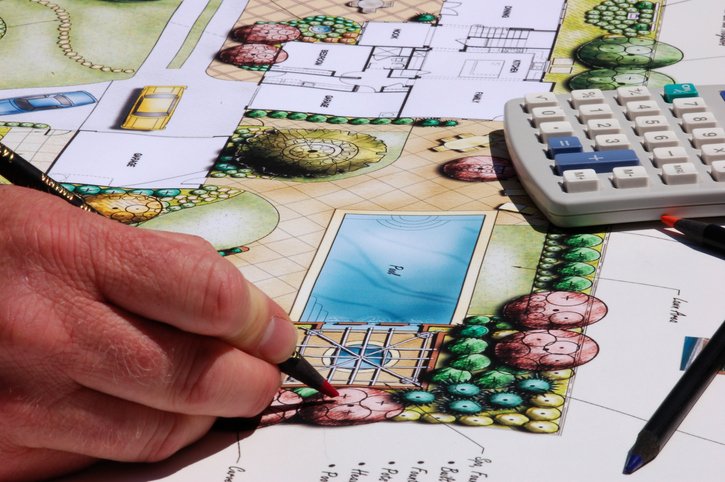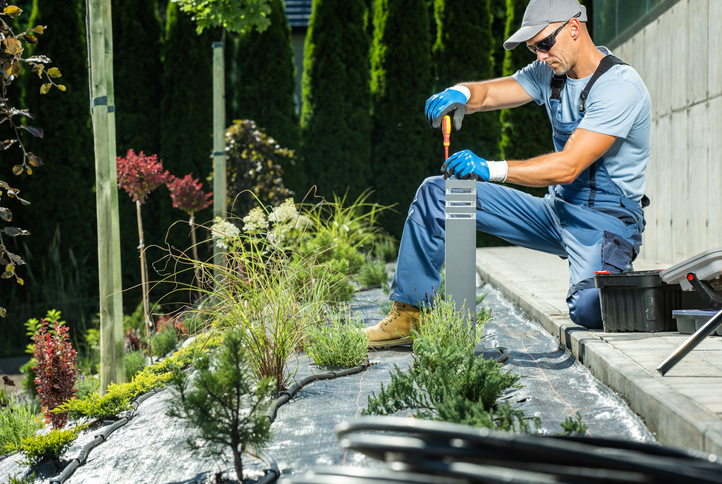Planning Your Low Voltage Outdoor Landscape Lighting
Updated 10/17/23 by 1000Bulbs Staff
A dark yard is a sad place of missed opportunities. Don't neglect to shine a light on your favorite outdoor spaces, such as flower beds, pathways, a pool, outdoor living spaces, or even the garden fountain deserve a spotlight. If you're ready to show off your outdoor space and illuminate walkways after the sun has gone down, then some DIY landscape lighting is in your future.
Although you can install a lighting system that runs on standard 120 voltage from your house, a lower voltage system is recommended for DIY installations due to safety and cost. Here are the key components of 12-Volt landscape lighting systems, including extra tips and a few ideas on how to become the best-lit house on the block.
NOTE: Before you dig, or even plan to dig, call the number 811. This will alert the utility companies of your intention to dig so they can come out and mark the approximate location of your underground utility lines. Lines are sometimes buried just a few inches in the ground. A locator should come out within 2-3 working days to mark your property or the area you intend to dig.
Design Your Lighting System to Illuminate Your Favorite Features
Whether you decide to use a low-voltage lighting kit or buy pieces individually, you'll need a plan of action. Ask yourself how you want to light your yard. You can use lighting to highlight your favorite plants and features like statues, trees, or flag poles. You could focus on increasing safety with your lighting, using lights to illuminate paths, driveways, and steps.
Be sure to consider lawn maintenance as well, including the use of abrasive chemicals like those that may be present in fertilizer that could potentially corrode your fixtures. Also, consider typical lawn care requirements. Nothing is more disheartening than taking out a ground fixture with a weed whacker or cutting through your wiring with a lawnmower.
Lighting Tip: Avoid over lighting an area. Outdoor lighting should accent the beauty of your yard. Rather than illuminate everything like a sports stadium, seek to create of pools of light that allow features to stand out. Be selective in the areas you emphasize with your outdoor lighting system.
Choosing the Right Fixtures for Your Space
Once you take your needs and your rampaging mower into account, you can decide on more practical things, like how many fixtures you need to install and the path the wiring should follow. Here are some types of landscape lights you can use:
Landscape Bullets (for spotlighting trees and other objects)
Flood Fixtures (for general uplighting or wall lighting effects)
In Ground Well Lights
Underwater lighting (for ponds and fountains)
Post Top Lamp Posts
Using Transformers for Your Low Voltage Lighting System
A transformer or two is an absolute necessity when it comes to low-voltage landscape lighting. These transformers are used to step down the 120 Volts coming from your house to 12 Volts for your outdoor lights. You will also need 100 feet or more of landscape wire and a square-blade shovel.
When choosing landscape lighting transformers, be sure to consider the transformer's capacity. It must be able to handle the total wattage of your fixtures. For example, if all of your fixtures use a total of 200 Watts, then you need a transformer with a maximum output of 200 Watts or more. If you think you might add more lights in the future then choose a transformer with a maximum wattage that's 100 to 200 Watts higher than you currently need.
While LED lights are becoming a more popular choice for this kind of project, if you decide to go with traditional halogen lighting then you will need a transformer with a maximum wattage of 20% more than your total wattage. That means the transformer should never be loaded with more than 80% capacity of its rated max wattage. This is called derating and helps to account for inefficiencies in the transformers.
Choosing the Right Low Voltage Landscape Wire
Wiring or electrical cable for low voltage landscape lighting comes in several numerical gauges or sizes. A lower number means the wire is thicker and has a greater capacity to carry the power current for longer distances. Common wires for landscape lighting systems are 10-, 12-, 14-, or 16-gauge wires. We recommend 12-gauge or 10-gauge wire for long distances to prevent voltage drop. The further you get from the transformer and its power supply, the more resistance occurs in the circuit which causes the voltage to decrease.
Lighting Tip: You can run 12-gauge about 100 feet without voltage drop issues as long as the total wattage of the fixtures on the wire is 100 Watts or less.
Chart showing recommended cable gauge and cable length for transformers.
When installing a new low voltage landscape lighting system, ensure all wires and connectors are listed for direct burial which helps prevent corrosion and other weather-related problems over time.
Low Voltage Landscape Lighting Essentials
There are other low voltage lighting supplies you might need depending on your design or preferences. Optional materials include:
A timer or photocell, if it’s not already built into the transformer
Weatherproof wire nuts with sealant in them
Weatherproof cover for your GFCI outlet (if your transformer is a plug-in model)
Aluminum tent stakes
Wire clips and stainless steel screws for mounting cables to trees
Weather-treated wood post for your transformer
Voltmeter
PVC pipes, couplers, and caps to weatherproof connections to path lights
Tips and Tricks for Attractive, Effective Landscape Lights
Last but not least, here are a few more tips to help you in the planning stage:
The first fixture should be at least 10 feet from your transformer to prevent it from getting too much voltage and burning out prematurely.
To avoid voltage drop, consider running either multiple straight runs in several directions, a tee connection run, or a looped run (more about types of wiring layouts in Part 2).
Try to center the transformer in your design. It makes it easier to wire the system in cases where you have to split between two or more runs.
Pathway lights should be spaced about 8 to 10 feet apart.
LED landscape lights are also available, which use far less power than traditional halogen or incandescent lighting.
Contact us at 1000bulbs.com for Help
Remember to take your time and plan your landscape lighting with care. Part two of this how-to will cover the installation of your low voltage landscape lighting systems. If you need more advice call our knowledgeable team of lighting experts at 1-800-624-4488.












